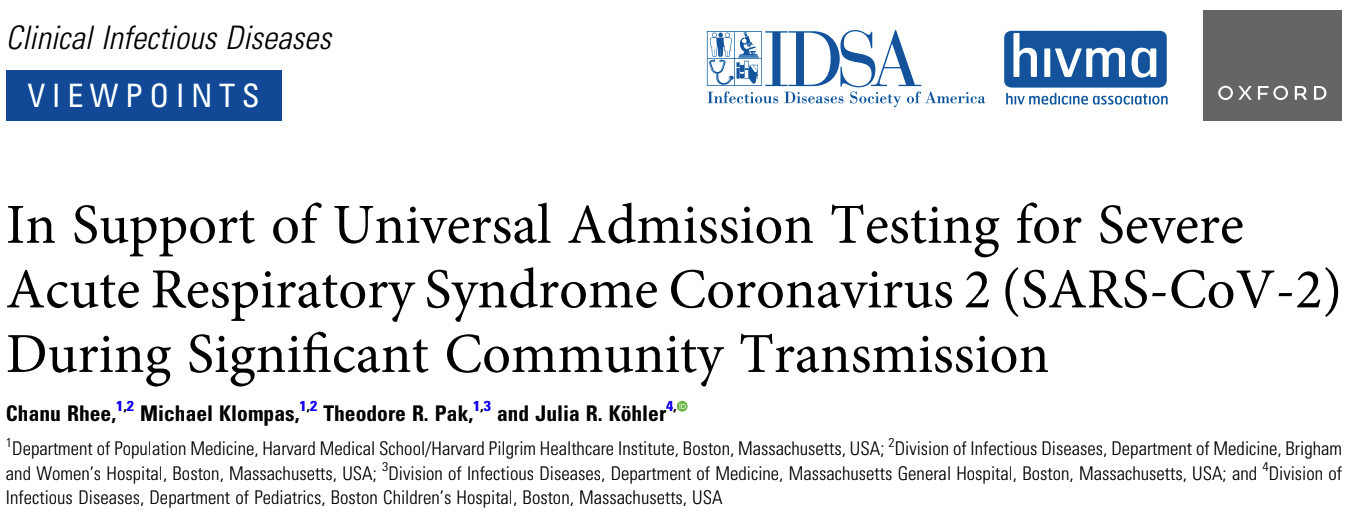Asymptomatic COVID-19 Screening At Hospitals
Many US hospitals have already or will soon stop testing all admitted patients for COVID-19. To support this decision, policymakers will likely cite new recommendations released by the Society for Healthcare Epidemiology of America (SHEA), the professional society that encompasses most hospital epidemiologists in the US.
Interestingly, SHEA’s position paper in ICHE was guarded in its conclusions, stating “the use of asymptomatic screening is a unique yet resource-intensive tool that arguably has been overused” and that “support and funding are needed for high-quality studies to examine the use of asymptomatic screening”—in essence, that we don’t have enough data to fully know the costs and benefits of the practice. On the other hand, the corresponding press release took it a step farther, leading off with, “Healthcare facilities should no longer routinely screen symptom-free patients for COVID-19 upon admission or before procedures.” So, this is likely to be the takeaway for hospitals: that they can and should stop all asymptomatic testing for COVID-19.
In a countering Viewpoint that my research mentors Mike Klompas and Chanu Rhee, Julia Köhler at Boston Children’s, and I wrote for Clinical Infectious Diseases, we offer seven reasons why testing should continue,1 particularly during times of increased community transmission.

Here’s the top-line points:
-
Hospital-acquired COVID-19 remains common but under-reported and under-appreciated. Earlier studies found that ~15% of admitted patients with COVID-19 acquired it in hospitals. Omicron associated with another uptrend in hospital-onset cases, as could be seen in our healthcare system in Massachusetts.
-
Presymptomatic and asymptomatic patients pose the highest risk. Viral loads are highest just before symptoms (if any) start. So, most transmissions are from people without symptoms. If you don’t screen all admissions, you’ll never catch it in time.
-
Transmission risk in shared patient rooms is high. The transmission rate from a patient with undiagnosed COVID-19 to an uninfected patient in the same room is 20-40%; in one Boston academic center early in the pandemic, with both universal testing and masking in place, it was 39%. Most US hospitals have lots of shared rooms. And patients don’t get to pick their roommates.
-
Hospital-acquired COVID-19 still causes substantial morbidity and mortality. In vulnerable inpatients, Omicron is far from “mild” (the infamous epithet it was given by talking heads in the media shortly before it killed more Americans than any prior variant). Crude mortality rates for hospital-onset Omicron are as high as 13% in other countries’ national health system data. In a propensity-matched study of 1,095 hospital-onset COVID patients that we published in Annals of Internal Medicine, we found that patients infected with hospital-onset Omicron experienced 64% higher mortality than matched uninfected controls. We already undertake enormously expensive measures to stop nosocomial infections like MRSA, VRE, and Clostridium difficile, all of which have arguably lower attributable risks to hospital inpatients than COVID-19. For example, some hospitals (including MGH and BWH) perform asymptomatic screening of all ICU patients for MRSA and VRE using periodic swab testing.
-
More testing is associated with fewer nosocomial cases and better outcomes. When England and Scotland stopped universal admission testing in Aug-Sep 2022, hospital-onset cases rose by 26-41% compared to community-onset infections.2
-
Potential downsides of asymptomatic testing are real, but can be mitigated. The cost ($55/patient in 1 study) is minimal compared to 1 inpatient-day ($3-10k). False positives occur, but retesting and discontinuing precautions can be automated, as many US healthcare systems figured out during the pandemic. Mass General Brigham automated this process using an Epic SmartForm called CORAL.
-
Hospitals have an ethical responsibility to protect patients from COVID-19. Forcing all patients to accept increased risk of COVID-19 when they enter hospitals in exchange for minimal benefit (saving $55, avoiding unnecessary airborne isolation, small differences in care timeliness) violates non-maleficence and beneficence. As COVID-19 has disproportionately harmed Black, Latinx, and Native American populations in the US, and continues to pose the highest risk to elderly, immunocompromised, and disabled people, the removal of various layers of COVID-19 precautions in hospitals will worsen systematic healthcare inequity in the US.
As an aside: Universal masking in hospitals is also under fire, so when “existing layers of protection” are offered as the compensatory mechanism that justifies ending asymptomatic respiratory viral testing, it is hard to accept such arguments in good faith.
In conclusion, we believe that more evidence and a serious plan for monitoring potential harms is needed before hospitals end universal admission testing. For more, read our full editorial in CID.
-
First released as a preprint and also as a Twitter thread. ↩
-
When we published these results, the most common concern raised was that this increase was biased by misclassification of asymptomatic shedding cases as hospital-onset cases after the policy change. We’ve now replicated an even larger increase across a regional US healthcare system that ended both universal admission testing and masking simultaneously in May 2023, and we used chart reviews to find that there is a neglible proportion of misclassified hospital-onset cases after the policy change. ↩
Discuss this post on HN.